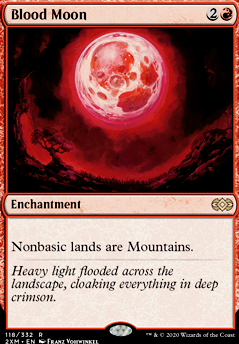The goal of Blue Moon is much like any other control deck - stall your opponent until you are safe dropping a threat with the mana open for counter magic. We run a myriad of cheap counter spells in addition to red removal to keep the board clear of threats. Unlike other control decks, we have another weapon in our mainboard:
Blood Moon. With decks that heavily rely on mana fixing and complicated land bases dominating the format (BG/x variants, for example), we are well positioned to lock them out of the game for a few turns once we drop the Moon. Post-board games get tricky though, as your opponents know to fetch their basic lands and sideboard in enchantment removal, should they be running any. However, we are a control deck, and can also side in counters specifically in anticipation of this removal.
Abrupt Decay is a problem, but we run enough card draw to hopefully stall the game and/or find another Moon. Early turns (1-3) are spent denying our opponents their spells through cheap counter magic and removal. We can also dig through our library for more answers with cantrips and draw filters. Very rarely will we have a Snapcaster or Clique on the field at this point, as we want to slow down our opponent before swinging in for damage. Our moves on the mid-game turns (say, turns 4-6) vary depending on the match. Against some decks, we want to get a
Blood Moon out as early as possible to prevent them from casting anything. For example, Eldrazi variants can be dropping 4-drops on turn two. The earlier the Moon the better. Other decks like Abzan and Zoo can be drastically impacted by this, especially if they haven't found their basics yet. Otherwise, sit back and counter your opponent's threats until they're low on resources.Once we hit the late game (turn 5-6+) is when we start looking to win. When we're safe to drop a
Pia and Kiran Nalaar
or
Batterskull with counter magic support, we are in the home stretch. Depending on the match, Snapcasters damage can even win the game.It is important for the Blue Moon pilot to realize that they can't rely heavily on
Blood Moon itself. While it can certainly turn a match around, you need to play with the expectation that, despite running the full playset, you may not draw one throughout the entire game. This can make many matches more difficult, but it doesn't mean we have lost. At its core, this is a control deck meant to stall games until we can land a threat. That threat does not have to be
Blood Moon.

